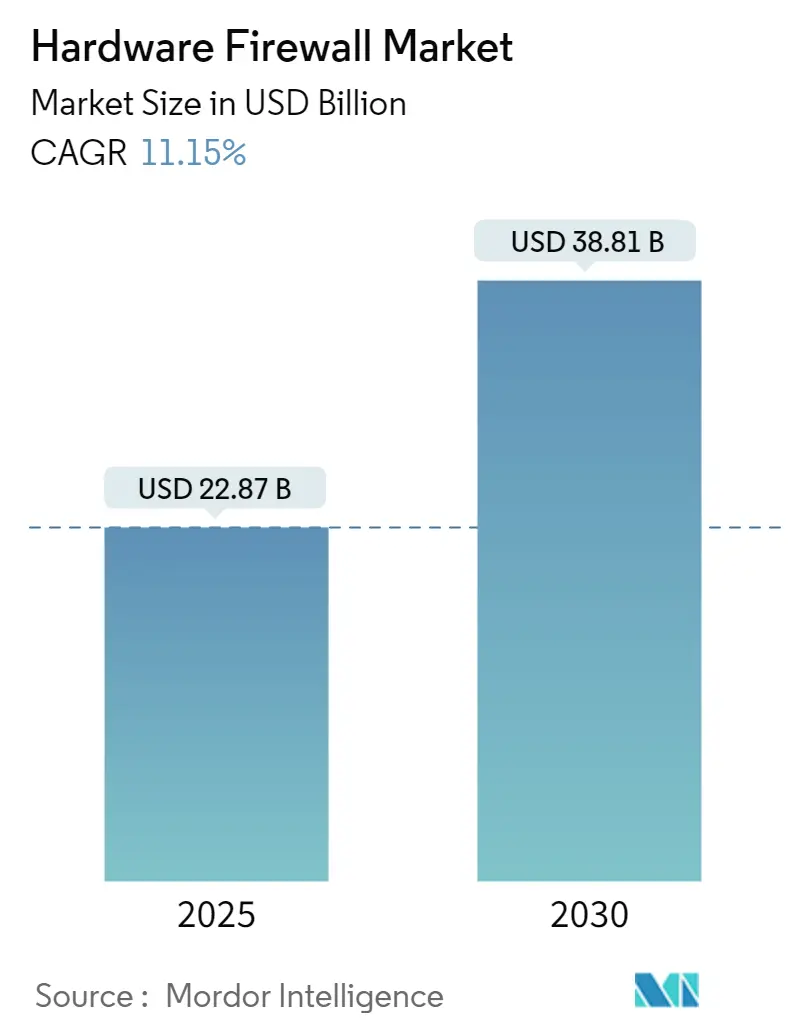
| Study Period | 2019 - 2030 |
| Market Size (2025) | USD 22.87 Billion |
| Market Size (2030) | USD 38.81 Billion |
| CAGR (2025 - 2030) | 11.15 % |
| Fastest Growing Market | Asia Pacific |
| Largest Market | North America |
| Market Concentration | Low |
Major Players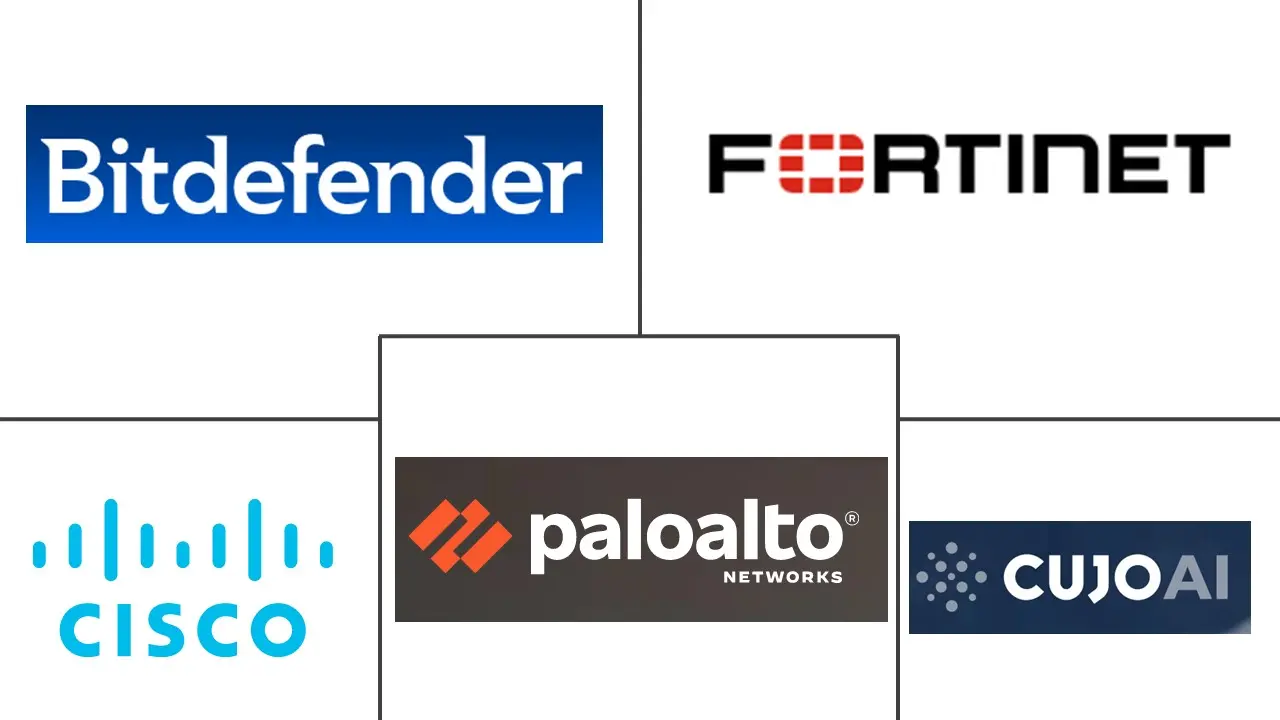
*Disclaimer: Major Players sorted in no particular order |
Hardware Firewall Market Analysis
The Hardware Firewall Market size is estimated at USD 22.87 billion in 2025, and is expected to reach USD 38.81 billion by 2030, at a CAGR of 11.15% during the forecast period (2025-2030).
The hardware firewall industry is experiencing significant transformation driven by the escalating sophistication of cyber threats and technological advancements. According to the Identity Theft Resource Center, the United States alone witnessed approximately 1,802 data compromise cases in 2022, highlighting the critical need for robust network firewall hardware solutions. The integration of artificial intelligence and machine learning capabilities in firewall hardware is enabling more sophisticated threat detection and automated response mechanisms. The industry is witnessing a shift towards more comprehensive security solutions that combine traditional firewall capabilities with advanced threat prevention features, including intrusion prevention systems and deep packet inspection.
The convergence of IT and OT (Operational Technology) networks is reshaping the hardware firewall landscape, particularly in industrial and manufacturing sectors. Recent technological innovations have focused on developing specialized hardware-based firewall solutions that can protect both traditional IT networks and industrial control systems. In February 2023, Fortinet introduced FortiSP5, a significant advancement in ASIC technology, demonstrating the industry's commitment to enhancing security capabilities for dispersed network edges. This development reflects the broader trend of firewall hardware manufacturers investing in custom silicon to improve performance and security capabilities.
The evolution of enterprise network architectures, particularly with the adoption of hybrid and multi-cloud environments, is driving innovation in enterprise firewall hardware solutions. According to cybersecurity statistics from Singapore, approximately 73% of cybersecurity incidents led to actual breaches in 2022, compared to 34% globally, emphasizing the need for more robust security measures. Network firewall hardware vendors are responding by developing solutions that can seamlessly integrate with cloud services while maintaining high-performance security capabilities for on-premises infrastructure. The industry is witnessing increased focus on scalability and flexibility in physical firewall deployments to accommodate diverse enterprise requirements.
International cooperation and standardization efforts are becoming increasingly important in shaping the hardware firewall market landscape. In January 2023, the United States and Japan signed an updated memorandum of cooperation on cybersecurity to strengthen operational collaboration, exemplifying the growing trend of international partnerships in cybersecurity. Firewall hardware manufacturers are adapting their products to comply with various international standards and regulations while maintaining competitive performance capabilities. The industry is seeing a trend towards more standardized security protocols and interoperability features, enabling better integration with existing security infrastructure and facilitating global deployment of firewall hardware solutions.
Hardware Firewall Market Trends
Administrative Regulations Encouraging Network Security Application Firewall
Government agencies worldwide are implementing stringent cybersecurity regulations and frameworks to protect critical digital infrastructure and sensitive data. The White House's release of the National Cybersecurity Strategy in March 2023 marks a significant shift in the regulatory landscape, focusing on realigning incentives for long-term security investments and rebalancing cybersecurity responsibilities. This comprehensive strategy demonstrates the growing emphasis on network security hardware market at the highest levels of government, pushing organizations to adopt robust hardware firewall solutions. The introduction of sector-specific legislation, such as the Healthcare Cybersecurity Act in the United States, further illustrates the regulatory push toward enhanced hardware firewall security system measures, particularly in critical sectors handling sensitive data.
The regulatory framework is becoming increasingly sophisticated, with governments fostering partnerships between the public and private sectors to strengthen cybersecurity measures. For instance, the collaboration between the Cybersecurity and Infrastructure Security Agency (CISA) and Health and Human Services (HHS) represents a coordinated approach to enhancing cybersecurity across the healthcare sector. These partnerships are crucial in developing and implementing effective network security firewall market standards, as they combine regulatory oversight with industry expertise. The increasing adoption of Electronic Health Records (EHR) systems, as evidenced by the 81% usage rate in Emilia-Romagna, Italy in Q4 2023, further emphasizes the need for robust security measures to comply with data protection regulations and maintain patient privacy.
Rising Sophistication of Attacks on Critical Infrastructure
The escalating sophistication of cyber attacks on critical infrastructure has become a pressing concern, particularly in sectors handling sensitive data and essential services. In 2022, the United States alone witnessed approximately 1,802 data compromise cases, affecting over 422 million individuals through various forms of data breaches, leakages, and exposures. The healthcare sector, in particular, has become a prime target for sophisticated cyber attacks, with threat actors employing advanced malware like Zeppelin to target healthcare organizations and other critical infrastructure. These attacks have prompted organizations to strengthen their network security measures, particularly through the implementation of advanced firewall equipment solutions.
The evolution of cyber threats has led to the development of more sophisticated security solutions by industry leaders. For example, Palo Alto Networks' launch of its Medical IoT Security offering in December 2022 represents a response to the growing complexity of cyber threats in the healthcare sector. This development highlights the industry's recognition of the need for specialized security solutions that can protect not only traditional network endpoints but also connected medical devices and IoT infrastructure. The FBI and CISA's joint cybersecurity advisory warning about ransomware threats further emphasizes the critical nature of these sophisticated attacks and the need for robust security measures to protect critical infrastructure across various sectors.
Segment Analysis: By Component
Device/System Segment in Hardware Firewall Market
The Device/System segment continues to dominate the global hardware firewall market, commanding approximately 79% market share in 2024. This significant market position is attributed to the increasing demand for dedicated firewall hardware devices across various industries to protect against sophisticated cyber threats. Organizations are increasingly investing in hardware firewall devices due to their superior performance capabilities, dedicated processing power, and ability to handle high-volume network traffic without compromising security. The segment's growth is further driven by the introduction of next-generation network firewall appliances that incorporate advanced features such as intrusion prevention, deep packet inspection, and application-level filtering. Major vendors like Fortinet, Palo Alto Networks, and Cisco are continuously innovating their hardware firewall product portfolios to address evolving security challenges and maintain their market positions.
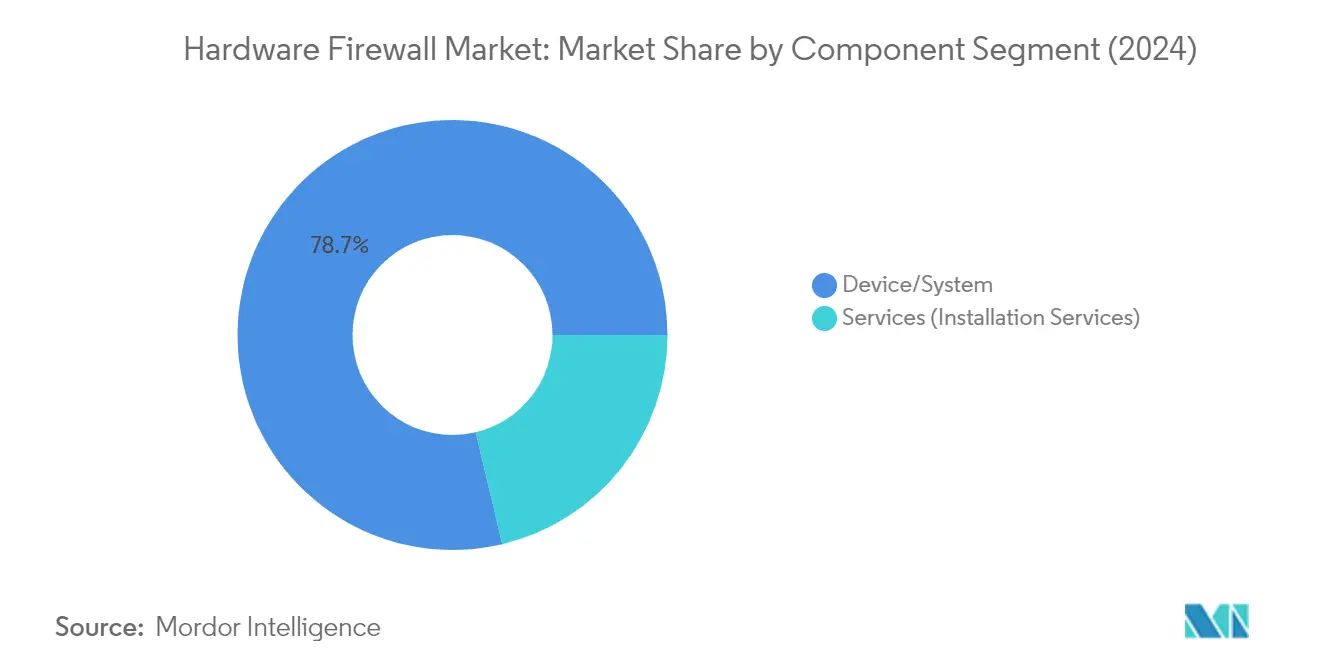
Services Segment in Hardware Firewall Market
The Services segment in the hardware firewall market is experiencing rapid growth, projected to expand at approximately 13% CAGR from 2024 to 2029. This accelerated growth is driven by the increasing complexity of network security requirements and the growing need for professional installation and configuration services. Organizations are recognizing the importance of expert implementation and maintenance services to ensure optimal firewall performance and security effectiveness. The segment's growth is further fueled by the rising demand for managed security services, where providers offer comprehensive firewall installation, configuration, and maintenance support. Additionally, the increasing adoption of hybrid work environments and complex network architectures has created a strong demand for professional services to ensure proper firewall deployment and integration with existing security infrastructure.
Segment Analysis: By Organization Size
Large Enterprises Segment in Hardware Firewall Market
The Large Enterprises segment dominates the global hardware firewall market, commanding approximately 67% market share in 2024. This significant market position is primarily driven by the increasing trend toward converged/virtualized networks, which presents new opportunities for firewall hardware vendors. Large enterprises typically employ dedicated hardware firewalls that require advanced IT skills for deployment and are managed by dedicated IT specialists or departments. These organizations prioritize comprehensive security coverage and are investing heavily in next-generation firewalls (NGFWs) to protect their complex network infrastructures. The segment's dominance is further strengthened by the rapid expansion of cloud-based services and bring-your-own-device policies, which increases the number of devices requiring security on corporate networks.
SMEs Segment in Hardware Firewall Market
The Small and Medium Enterprises (SMEs) segment is projected to experience the fastest growth in the hardware firewall market during 2024-2029, with an estimated growth rate of approximately 14%. This accelerated growth is attributed to the increasing recognition among smaller businesses of the critical importance of network security. SMEs are particularly attracted to hardware firewall for business solutions that combine hardware components with software controls, providing comprehensive security features including VPN support, antivirus, antispam, antispyware, and content filtering capabilities. The segment's growth is further fueled by the availability of integrated small office/home office routers with firewall features from numerous vendors and internet service providers (ISPs), making enterprise-grade security more accessible and affordable for smaller organizations.
Segment Analysis: By End-User Industry
IT and Telecom Segment in Hardware Firewall Market
The IT and telecommunications sector dominates the hardware firewall market, holding approximately 28% market share in 2024, driven by the critical need to protect vast amounts of sensitive data and infrastructure. As major components of any country's critical infrastructure, IT and telecom companies face sophisticated cyber threats that could have far-reaching consequences across multiple industries that depend on their services. The increasing adoption of new technologies like 5G, IoT, cloud computing, and digital services has expanded the attack surface, making robust network security essential. Telecom operators are particularly vulnerable as they store extensive personal and financial customer data, making them prime targets for cybercriminals seeking to conduct identity theft, financial fraud, or launch further attacks. The transformation of telecom operators from traditional network companies to cloud service providers has created additional security challenges that necessitate advanced firewall protection.
Healthcare Segment in Hardware Firewall Market
The healthcare sector is emerging as the fastest-growing segment in the hardware firewall market, projected to grow at approximately 12% during 2024-2029. This rapid growth is driven by the increasing digitization of healthcare services, including Electronic Health Records (EHRs), online patient portals, and connected medical devices. Healthcare organizations require more comprehensive firewalls than other sectors due to the high value of clinical data and the numerous potential entry points for unauthorized access. The widespread adoption of connected medical devices and Wi-Fi-enabled equipment for patient data collection and health monitoring has created additional security vulnerabilities that need robust protection. The sector's growing reliance on digital infrastructure, combined with strict regulatory requirements for protecting patient data, continues to drive investment in advanced firewall solutions.
Remaining Segments in End-User Industry
The hardware firewall market encompasses several other significant segments including government, manufacturing, education, and other industries. The government sector demonstrates strong demand driven by digitization initiatives and the need to protect classified information and critical infrastructure. The manufacturing sector's adoption is primarily fueled by Industry 4.0 initiatives and the increasing connectivity of operational technology networks. The education sector, while smaller, shows consistent demand due to the digital transformation of educational institutions and the need to protect student data and research information. Other industries, including retail and defense, contribute significantly to the market as they seek to protect their digital assets and comply with various security regulations. Each of these segments presents unique security challenges and requirements, driving the continued evolution and adoption of hardware firewall for home solutions.
Hardware Firewall Market Geography Segment Analysis
Hardware Firewall Market in North America
North America represents a dominant force in the global hardware firewall market, driven by the presence of major technology companies and increasing cybersecurity concerns. The region's market growth is supported by significant initiatives taken by the government to secure countries against cyberattacks, particularly in the United States. The widespread adoption of cloud computing, IoT devices, and digital transformation across industries has created a strong demand for robust network firewall hardware solutions. The region demonstrates a mature market infrastructure with advanced technological capabilities and a high awareness of cybersecurity threats among organizations. The presence of leading hardware firewall manufacturers and continuous innovation in security solutions further strengthens the market position of North America in the global landscape.
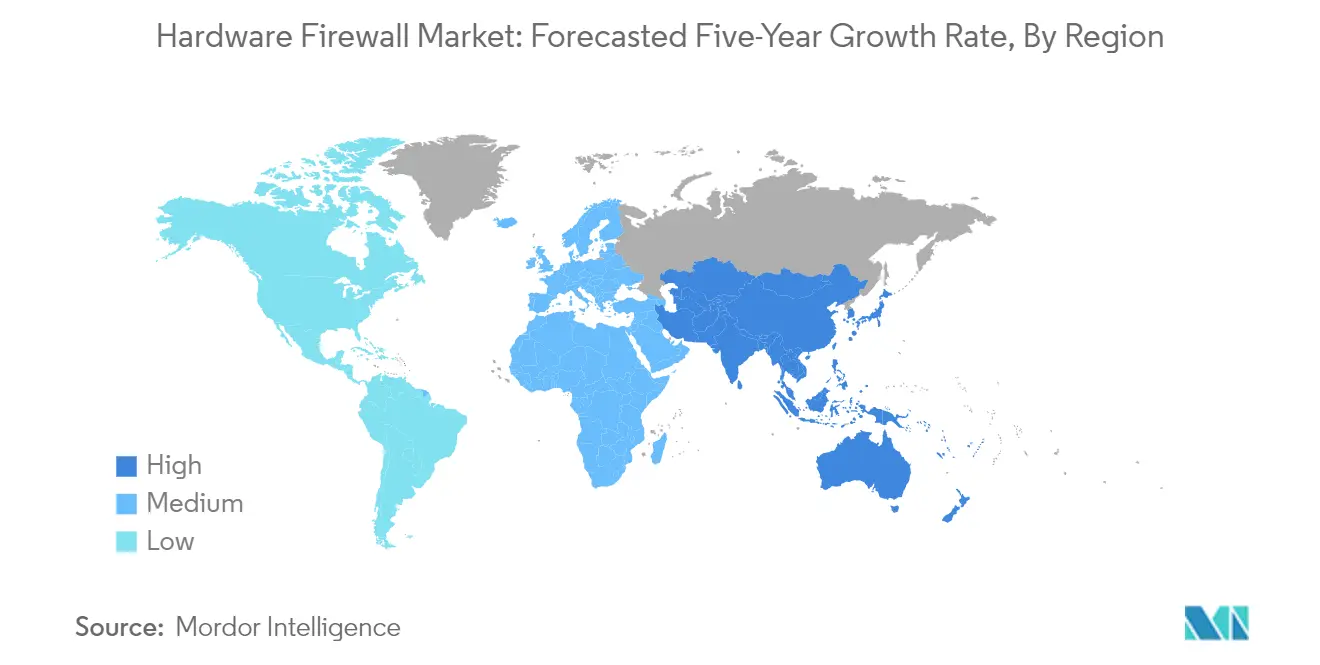
Hardware Firewall Market in Europe
The European firewall market exhibits strong growth potential, supported by stringent data protection regulations and increasing cyber threats targeting critical infrastructure. The region's market is characterized by a high adoption rate of advanced security solutions across various industries, particularly in countries like the United Kingdom, Germany, and France. The increasing focus on protecting critical national infrastructure in various sectors, including energy, aviation, banking, healthcare, and public services, drives the demand for hardware firewall solutions. The market is further strengthened by collaborative efforts between governments and the private sector to enhance cybersecurity measures and protect against sophisticated cyber threats. The region's commitment to digital transformation while maintaining robust security measures continues to drive market growth.
Hardware Firewall Market in Asia-Pacific
The Asia-Pacific region demonstrates significant growth potential in the hardware firewall market, characterized by rapid digital transformation and increasing cybersecurity awareness. The region encompasses diverse markets with varying levels of technological adoption, from mature markets like Japan and South Korea to emerging economies like India and Southeast Asian nations. The increasing adoption of cloud services, expansion of e-commerce platforms, and growing digital infrastructure across countries create a strong demand for firewall hardware solutions. The region's market is further driven by government initiatives promoting cybersecurity and digital transformation across various sectors.
Hardware Firewall Market in China
China leads the Asia-Pacific hardware firewall market with its extensive digital infrastructure and growing emphasis on cybersecurity. The country's market is driven by technological advancements, an increasing number of connected devices, and the growing organizational propensity toward digitization. With approximately 44% market share in the APAC region by 2024, China continues to dominate the regional market. The country's focus on improving defense capabilities against cyber threats, coupled with government initiatives promoting cybersecurity measures, creates a robust environment for market growth.
Hardware Firewall Market in Singapore
Singapore emerges as the fastest-growing market in the Asia-Pacific region, with a projected growth rate of approximately 24% during 2024-2029. The country's position as a leading technology hub, coupled with its strong focus on cybersecurity initiatives, drives market growth. Singapore's robust technology sector, well-developed business infrastructure, and substantial investment opportunities create an ideal environment for hardware firewall device adoption. The country's commitment to digital transformation and cybersecurity excellence, supported by government initiatives and private sector investments, continues to fuel market expansion.
Hardware Firewall Market in Middle East & Africa
The Middle East & Africa firewall market shows promising growth potential, driven by increasing digital transformation initiatives and rising cybersecurity concerns. Countries such as Saudi Arabia, UAE, and Egypt are working on improving network security through government efforts and growing interest from global and local vendors. The region's focus on protecting critical infrastructure and government data, coupled with increasing cyber threats, drives the adoption of hardware firewall solutions. The market benefits from collaborations between international security providers and local organizations to address regional cybersecurity challenges.
Hardware Firewall Market in Latin America
The Latin American hardware firewall market demonstrates strong growth potential, driven by digital transformation initiatives and increasing awareness of cybersecurity threats. The region's market is characterized by the expansion of e-commerce platforms, deployment of cloud solutions, and proliferation of smart devices. The presence of multiple market incumbents and current security threats in the region drives the adoption of hardware firewall devices. The advancement in firewall technology, along with increased network security expenditure by several organizations, continues to fuel market growth in the region.
Hardware Firewall Industry Overview
Top Companies in Hardware Firewall Market
The hardware firewall market is dominated by established players like Cisco Systems, Palo Alto Networks, Fortinet, Check Point Software Technologies, and other prominent vendors. These hardware firewall companies are heavily investing in research and development to enhance their product portfolios with advanced features such as artificial intelligence, machine learning capabilities, and improved threat detection mechanisms. The industry is witnessing significant innovation in areas such as next-generation firewalls (NGFW), cloud integration capabilities, and software-defined networking solutions. Companies are focusing on strategic partnerships and collaborations to strengthen their market presence and expand their technological capabilities. Operational agility is being achieved through the development of scalable solutions that can adapt to varying enterprise needs, while geographic expansion is primarily targeted through strong channel partner networks and localized service offerings.
Consolidated Market with Strong Global Players
The firewall market share exhibits a relatively consolidated structure dominated by global technology conglomerates with extensive cybersecurity portfolios. These major players leverage their established brand reputation, extensive distribution networks, and substantial research capabilities to maintain their market positions. The market demonstrates a mix of pure-play cybersecurity specialists and diversified technology companies, with the latter having advantages in terms of integrated solution offerings and cross-selling opportunities. Market consolidation is primarily driven by larger companies acquiring specialized security firms to enhance their technological capabilities and expand their product offerings.
The competitive dynamics are characterized by intense rivalry among established players, with high barriers to entry due to significant technological requirements and the need for established customer relationships. Merger and acquisition activities are focused on acquiring innovative startups with specialized capabilities in emerging areas like cloud security, artificial intelligence-based threat detection, and advanced firewall technologies. Regional players maintain their presence through specialized offerings and strong local customer relationships, though they face increasing pressure from global players expanding their geographical footprint.
Innovation and Adaptability Drive Market Success
Success in the hardware firewall market increasingly depends on vendors' ability to provide comprehensive security solutions that integrate seamlessly with existing enterprise infrastructure. Incumbent players are focusing on developing more sophisticated threat detection capabilities, improving performance metrics, and offering enhanced scalability options to maintain their market positions. The ability to provide customized solutions for different industry verticals, coupled with strong after-sales support and professional services, has become crucial for maintaining a competitive advantage. Companies are also investing in developing more user-friendly interfaces and automated security features to address the growing demand for simplified security management.
For contenders looking to gain market share, specialization in specific industry verticals or security niches offers a viable path forward. The increasing focus on regulatory compliance and data protection across different regions creates opportunities for vendors who can provide tailored solutions meeting specific regulatory requirements. The risk of substitution remains moderate, primarily from cloud-based security solutions and software-defined firewalls, pushing hardware firewall vendors to continuously innovate and integrate their solutions with emerging technologies. Success also increasingly depends on building strong ecosystem partnerships and maintaining robust channel relationships to ensure effective market reach and customer support capabilities. The NGFW competitive landscape is evolving, with vendors striving to enhance their firewall market share by vendor through innovation and strategic alliances.
Hardware Firewall Market Leaders
-
Bitdefender
-
Cisco Systems, Inc.
-
Cujo LLC
-
Fortinet Inc.
-
Palo Alto Networks Inc.
- *Disclaimer: Major Players sorted in no particular order
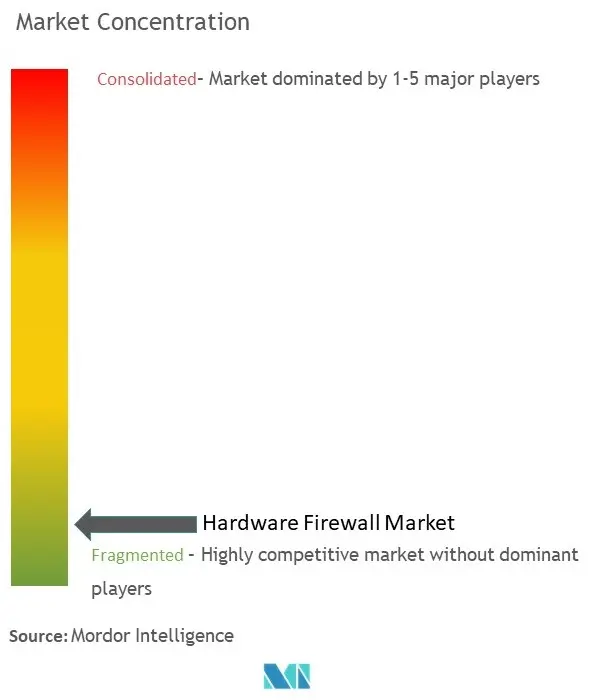
Hardware Firewall Market News
- April 2024: Firewalla launched its cost-effective 10-gigabit smart firewall, designed for next-generation Wi-Fi 7 and high-speed fiber networks. The company specializes in configurable hardware firewalls that connect to routers, providing robust protection for home or business networks against various online threats. The company has announced the pre-sale of Firewalla Gold Pro, the latest and most powerful addition to its "Gold" product line. This device is engineered to be compatible with next-generation Wi-Fi 7 and high-speed 5 and 10-gigabit ISP fiber networks.
- October 2023: Juniper Networks Inc. announced the launch of new firewall appliances and software tools designed to help companies secure their infrastructure. The company expanded its portfolio with four new firewall appliances that can block suspicious traffic in their networks. The hardware portfolio includes SRX1600, SRX2300, SRX4300, and SRX4700, which are powered to scan up to 1.4 terabits of network traffic per second for threats.
Hardware Firewall Market Report - Table of Contents
1. INTRODUCTION
- 1.1 Study Assumptions and Market Definition
- 1.2 Scope of the Study
2. RESEARCH METHODOLOGY
3. EXECUTIVE SUMMARY
4. MARKET INSIGHTS
- 4.1 Market Overview
- 4.2 Coverage of the Major Regional Vendors and Production Locations in the Firewall Market
- 4.3 Coverage of Supply-side Dynamics
- 4.4 Case Studies of Telcos
- 4.5 Coverage of Native vs Virtual Firewalls
-
4.6 Industry Attractiveness - Porter's Five Forces Analysis
- 4.6.1 Bargaining Power of Suppliers
- 4.6.2 Bargaining Power of Buyers
- 4.6.3 Threat of New Entrants
- 4.6.4 Threat of Substitute Products
- 4.6.5 Intensity of Competitive Rivalry
- 4.7 Industry Value Chain Analysis
- 4.8 Coverage of Firewall Demand in the Post-Pandemic Scenario
5. MARKET DYNAMICS
-
5.1 Market Drivers
- 5.1.1 Administrative Regulations Encouraging Network Security Application Firewall
- 5.1.2 Rising Sophistication of Attacks on Critical Infrastructure
-
5.2 Market Restraints
- 5.2.1 Heavy Capital Expenditure and Rising Adoption of Firewall-as-a-Service
- 5.3 Hardware Firewall Price Trend Analysis
- 5.4 Hardware Firewall - Technology Roadmap
-
5.5 Analysis of Types of Firewalls
- 5.5.1 Packet Filtering Firewalls
- 5.5.2 Circuit-level Gateways
- 5.5.3 Application-level Gateways
- 5.5.4 UTM Firewalls
6. MARKET SEGMENTATION
-
6.1 By Component
- 6.1.1 Device/System
- 6.1.2 Services (Installation Services)
-
6.2 By Organization Size
- 6.2.1 SMEs
- 6.2.2 Large Enterprises
-
6.3 By End-user Industry
- 6.3.1 Healthcare
- 6.3.2 Manufacturing
- 6.3.3 Government
- 6.3.4 IT and Telecom
- 6.3.5 Education
- 6.3.6 Other End-user Industries
-
6.4 By Geography
- 6.4.1 North America
- 6.4.2 Europe
- 6.4.3 Asia-Pacific
- 6.4.3.1 China
- 6.4.3.2 Japan
- 6.4.3.3 India
- 6.4.3.4 Malaysia
- 6.4.3.5 Thailand
- 6.4.3.6 Vietnam
- 6.4.3.7 Singapore
- 6.4.3.8 Philippines
- 6.4.3.9 Indonesia
- 6.4.4 Middle East and Africa
- 6.4.5 Latin America
7. COMPETITIVE LANDSCAPE
-
7.1 Company Profiles
- 7.1.1 Bitdefender
- 7.1.2 Cisco Systems Inc.
- 7.1.3 CUJO LLC
- 7.1.4 Fortinet Inc.
- 7.1.5 Palo Alto Networks Inc.
- 7.1.6 Netgate
- 7.1.7 Sonicwall Inc.
- 7.1.8 Sophos Ltd
- 7.1.9 WatchGuard Technologies Inc.
- 7.1.10 Check Point Software Technologies Ltd
- *List Not Exhaustive
8. VENDOR MARKET SHARE ANALYSIS
9. INVESTMENT ANALYSIS
Hardware Firewall Industry Segmentation
A firewall hardware, also known as a physical firewall device, is an appliance that fits between the client system and the uplink and filters traffic according to user profiles, security policies, and business rules that have been pre-configured. The uplink transmits traffic from private or public networks to the client system, which can be a server, a WFH system, an employee workstation, or an IoT node.
The hardware firewall market is segmented by component (device/system and services (installation services)), organization size (SMEs and large enterprises), end-user industry (healthcare, manufacturing, government, IT and telecom, and education), and geography (North America, Europe, Asia-Pacific (China, Japan, India, Malaysia, Thailand, Vietnam, Singapore, Philippines, Indonesia, Rest of Asia-Pacific), Middle East and Africa, and Latin America). The market sizes and forecasts are provided in terms of value (USD) for all the segments.
| By Component | Device/System | ||
| Services (Installation Services) | |||
| By Organization Size | SMEs | ||
| Large Enterprises | |||
| By End-user Industry | Healthcare | ||
| Manufacturing | |||
| Government | |||
| IT and Telecom | |||
| Education | |||
| Other End-user Industries | |||
| By Geography | North America | ||
| Europe | |||
| Asia-Pacific | China | ||
| Japan | |||
| India | |||
| Malaysia | |||
| Thailand | |||
| Vietnam | |||
| Singapore | |||
| Philippines | |||
| Indonesia | |||
| Middle East and Africa | |||
| Latin America | |||
Hardware Firewall Market Research Faqs
How big is the Hardware Firewall Market?
The Hardware Firewall Market size is expected to reach USD 22.87 billion in 2025 and grow at a CAGR of 11.15% to reach USD 38.81 billion by 2030.
What is the current Hardware Firewall Market size?
In 2025, the Hardware Firewall Market size is expected to reach USD 22.87 billion.
Who are the key players in Hardware Firewall Market?
Bitdefender, Cisco Systems, Inc., Cujo LLC, Fortinet Inc. and Palo Alto Networks Inc. are the major companies operating in the Hardware Firewall Market.
Which is the fastest growing region in Hardware Firewall Market?
Asia Pacific is estimated to grow at the highest CAGR over the forecast period (2025-2030).
Which region has the biggest share in Hardware Firewall Market?
In 2025, the North America accounts for the largest market share in Hardware Firewall Market.
What years does this Hardware Firewall Market cover, and what was the market size in 2024?
In 2024, the Hardware Firewall Market size was estimated at USD 20.32 billion. The report covers the Hardware Firewall Market historical market size for years: 2019, 2020, 2021, 2022, 2023 and 2024. The report also forecasts the Hardware Firewall Market size for years: 2025, 2026, 2027, 2028, 2029 and 2030.
Our Best Selling Reports
Hardware Firewall Market Research
Mordor Intelligence provides a comprehensive analysis of the hardware firewall industry, utilizing our extensive expertise in network security appliance research. Our latest report examines the evolving landscape of physical firewall technologies. It includes a detailed analysis of enterprise firewall hardware solutions and hardware-based firewall implementations. The report, available in an easy-to-download PDF format, covers emerging trends in network firewall hardware and firewall equipment. We focus particularly on hardware firewall for business applications and hardware firewall appliances.
Our analysis offers valuable insights for stakeholders across the firewall hardware ecosystem, from manufacturers of hardware firewall devices to solution providers. The report examines various aspects, including hardware firewall price trends and network firewall appliance specifications. It provides comprehensive evaluations of leading hardware firewall brands and hardware firewall companies. Special attention is given to both hardware firewall for home solutions and enterprise-grade implementations. We provide a detailed analysis of firewall server hardware capabilities and performance metrics of the fastest firewall in the world. The report also includes detailed sections on unified threat management systems and network security applications across different business scales.




